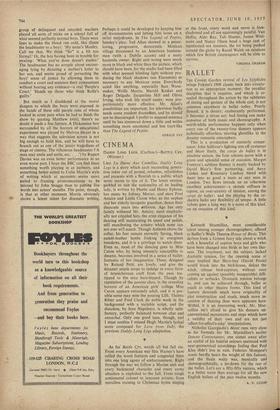BALLET
THE Covent Garden revival of Les Sylphides brings Fokine's 1908 classic back into circula- tion at an appropriate moment; the peculiar discipline that it requires, and which is re- vealed throughout the action by the subtleties of timing and gesture of the whole cast, is not common anywhere in ballet today. Poorly danced, it is dreary; exuberantly performed, it becomes a circus act; bad timing can make nonsense of both music and choreography. A worth-while performance happens only when every one of the twenty-four dancers appears technically effortless, moving ghostlike in the dreamy romantic atmosphere.
This is a production of masterly compe- tence; John Sullivan's lighting sets off costumes and ddcor finely, the corps de ballet is in absolute unison, the foilr soloists move with a grave and splendid sense of occasion. Margot Fonteyn's sublime fluency is neatly backed by David Blair's firm partnering; and Anya Linden and Rosemary Lindsay blend with them into as good a team as any seen in London. Two flaws intrude on an otherwise excellent achievement—a certain stiffness in repose, an over-anxiety of tension, among the corps de ballet: and the playing by the or- chestra lacks any flexibility of tempo. A little rubato goes a long way in a score of this kind, on an occasion of this kind.
Kenneth Macmillan, most considerable talent among younger choreographers, offered at Sadler's Wells Theatre, House of Birds. This derives from a Grimm fairy tale about a witch with a houseful of captive boys and girls who have been changed into birds in her own like- ness. The treatment, not the subject, lacked dramatic tension, for the opening scene at once implied that Hero-boy (David Poole) would break into the bird-house, defeat the witch, release bird-captives, without once coming up against (possibly insuperable) diffi- culties or setbacks. Dramatic tension belongs to, and can be achieved through, ballet as much as other theatre forms. This kind of fantasy demands much more originality of plot construction and much, much more in- vention of dancing than were apparent here. Withal, it is an interesting work; Mr. Mac- millan isn't afraid to give his dancers un- conventional movements and steps which have a validity of their own and are not just 'effect-for-effect's-sake' interpolations.
Nicholas Ge.orgiadis's dicor runs very close to his formula for Mr. Macmillan's earlier Danses Concertantes; one comes away after an eyeful of his baleful colours spattered with near-geometrical scratchings feeling that Paul Klee didn't live in vain. Federico Mompou's music hardly bears the weight of this fantasy, and the finale waltz was, musically and choreographically, a let-down for the rest of the ballet. Let's say a fifty-fifty success, which is a better score than average for all the new English ballets of the past twelve months.
A. V. COTON










































 Previous page
Previous page